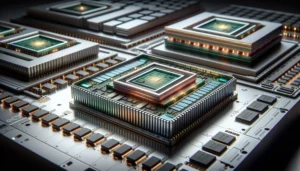Introduction:
In the world of modern technology, semiconductor lasers stand as unsung heroes, powering an array of applications that shape our daily lives. From communication systems to medical devices, these tiny yet powerful devices play a pivotal role.
Let’s delve into the heart of semiconductor lasers, understanding their workings, real-life analogies, applications, and the fascinating science behind their functionality.
Follow us on LinkedIn for everything around Semiconductors & AI
The Foundation of Light Emission
At the core of semiconductor lasers lies the principle of light emission through stimulated emission of radiation. To put it simply, think of it as a symphony of photons where electrons, excited within a semiconductor material, release photons as they return to a lower energy state. This process, known as electroluminescence, forms the foundation of semiconductor lasers.
Anatomy of a Semiconductor Laser
Breaking down the intricate structure of a semiconductor laser, we find a semiconductor material sandwiched between two layers of differently doped materials. The active layer, where light emission occurs, is crucial to the laser’s functionality. The doping of materials influences the conductivity, creating a dynamic environment for the controlled release of photons.
Analogy
Imagine a semiconductor laser as the miniature conductor orchestrating a traffic light. Electrons represent the vehicles, excited to move forward at a green light (energy absorbed), and as they return to a relaxed state at the red light (lower energy), they emit light. This orderly process mimics the precise emission of photons in a semiconductor laser.
Read More:What is CMOS Image Sensor Technology: From Light to Pixel – techovedas
Classification of Semiconductor lasers
Semiconductor lasers exhibit diverse characteristics, categorized along two primary axes: structure and application.
1. Structure:
| Homogeneous Lasers | Uniform composition, simple design, suitable for basic applications. |
|---|---|
| Heterogeneous Lasers | Varied compositions, enhanced performance, prevalent in advanced applications. |
| Edge-Emitting Lasers | Emit from chip edge, employed in fiber optics and telecommunications. |
| Vertical-Cavity Surface-Emitting Lasers (VCSELs) | Emit perpendicularly, compact design, used in optical interconnects. |
| Distributed Feedback Lasers (DFB) | Grating structure, high spectral purity, common in telecommunications. |
| Quantum Cascade Lasers (QCL) | Exploit quantum cascade transitions, emit mid-infrared to terahertz, suited for gas sensing. |
| Quantum Dot Lasers | Utilize quantum dots, improved stability, applied in telecommunications and amplifiers. |
2. Application:
| Basic | Homogeneous Lasers |
|---|---|
| Advanced | Heterogeneous Lasers |
| Telecommunications | Edge-Emitting Lasers, VCSELs, DFB |
| Infrared Sensing | QCL |
| Quantum Dot Applications | Quantum Dot Lasers |
This classification delineates the array of semiconductor lasers, aligning their unique structures with diverse applications.
Read More: What are Light Sensors – techovedas
Applications of Lasers
Semiconductor lasers have become indispensable in modern communication systems, particularly in the realm of fiber optics. These lasers, harnessed for their efficiency and precision, play a pivotal role in transmitting vast amounts of data at the speed of light.
Fiber Optic Communication:
Semiconductor lasers are the heart of fiber optic communication, where data is transmitted as pulses of light through thin glass fibers. Unlike traditional copper wires, this technology allows for high-speed, long-distance communication without signal degradation.
Internet Backbone:
In the vast network of the internet, semiconductor lasers are employed in the backbone infrastructure. Major data centers and telecommunication hubs utilize these lasers to ensure seamless and rapid data transfer between locations globally. For instance, companies like Google and Facebook heavily rely on semiconductor lasers to maintain the efficiency of their services.
Telecommunications:
In telecommunications, it is enable the transmission of voice, video, and data over long distances. Optical fibers equipped with these lasers facilitate clear and high-capacity communication, powering services like video conferencing and streaming.
Biomedical Applications:
It is find applications beyond communication, such as in biomedical fields. They are used in techniques like optical coherence tomography (OCT), providing high-resolution imaging in medical diagnostics and research.
Semiconductor lasers have transformed the landscape of communication, enabling the fast and reliable transfer of information in diverse fields. Their integration into fiber optic networks has been instrumental in shaping the connected world we live in today.
How do they work
Semiconductor lasers, the unsung heroes of modern technology, play a pivotal role in various applications, from communication to medical devices. Understanding their intricate workings is crucial to appreciating their significance.
Fundamentals of Operation
It operates on the principle of stimulated emission of photons within a semiconductor material. When electrical current is applied to the semiconductor, it energizes the atoms, leading to the emission of coherent light.
Active Medium and Gain
The heart of the semiconductor laser is its active medium, typically made of gallium arsenide. As electrons and holes recombine within this medium, they release energy in the form of photons. The amplification or gain is achieved through the feedback loop within the laser cavity.
Optical Cavity and Mirrors
A critical component is the optical cavity formed by two mirrors at the ends of the semiconductor. One mirror is highly reflective, while the other allows partial transmission. This arrangement enables the coherent light to build up in intensity.
Example:
In fiber optic communication, semiconductor lasers are the driving force behind high-speed data transmission. As electrical signals are converted into optical signals, it is ensure the efficient and rapid transmission of data through optical fibers, enabling the seamless connectivity we rely on in our digital age.
Advantages of semiconductor lasers
Semiconductor lasers have revolutionized various industries with their compact size and efficient performance. Their advantages stem from dynamic features that drive technological progress.
1. Enhanced Efficiency:
Semiconductor lasers boast high electrical-to-optical conversion efficiency, minimizing energy wastage. This efficiency is crucial in applications like telecommunications, where data transmission demands optimal power utilization.
2. Compact Form Factor:
The miniature size of semiconductor lasers facilitates integration into diverse devices, from medical equipment to consumer electronics. For instance, in barcode scanners, the compactness allows for seamless portability without compromising functionality.
3. Precision in Applications:
The inherent monochromatic and coherent properties of semiconductor lasers enable precise focusing, crucial in medical procedures like laser eye surgeries, ensuring accuracy and minimal collateral damage.
4. Rapid Modulation Rates:
Semiconductor lasers exhibit swift modulation, making them ideal for high-speed data transmission in fiber optics. This speed advantage enhances internet connectivity and data transfer rates.
Semiconductor lasers, with their intricate interplay of electrons and photons, are the backbone of diverse technologies, making them indispensable in our interconnected world. Understanding their inner workings unlocks a realm of possibilities for innovation and progress.
Future of Semiconductor Lasers
Semiconductor lasers, the unsung heroes of modern photonics, offer a myriad of benefits that drive innovation across diverse fields. These tiny yet powerful devices generate coherent light through stimulated emission, with applications ranging from telecommunications to medical devices.
Compact and Efficient Light Sources:
Semiconductor lasers boast unparalleled compactness, making them ideal for miniaturized electronic devices. Their efficiency in converting electrical energy into light reduces power consumption, a crucial factor in portable gadgets like smartphones.
Precision in Communication:
In the realm of telecommunications, it is play a pivotal role in high-speed data transmission. The precision and speed at which they emit light pulses enable seamless communication in fiber-optic networks, ensuring rapid and reliable information exchange.
Medical Marvels:
In medicine, semiconductor lasers find applications in surgeries and diagnostics. Lasers with specific wavelengths can precisely target tissues, facilitating non-invasive procedures and enabling breakthroughs in medical research.
Versatility in Research:
Researchers leverage semiconductor lasers for various spectroscopy techniques, allowing detailed analysis of materials at the molecular level. This versatility empowers scientists across disciplines, from chemistry to environmental science.
Semiconductor lasers, with their compact design, energy efficiency, and versatile applications, stand as pillars in advancing technology and scientific exploration. As innovation propels forward, the influence and significance of these lasers will only continue to grow.
Conclusion:
In conclusion, semiconductor lasers are the silent luminaries guiding our technological landscape. From the bustling world of communications to the intricacies of medical procedures, these devices play a pivotal role. Analogous to a conductor orchestrating a symphony of light, they are shaping the future with their active role in light emission. As we unravel the science behind their work function, we gain a deeper appreciation for the brilliance that it is bring to our world. As technology continues to advance, these tiny emissaries of light are sure to illuminate new paths and possibilities.








